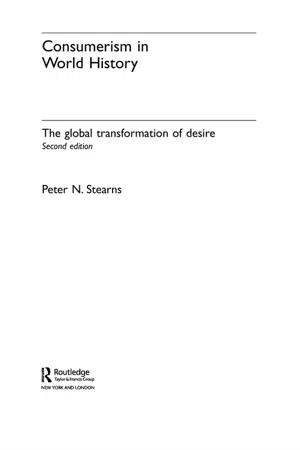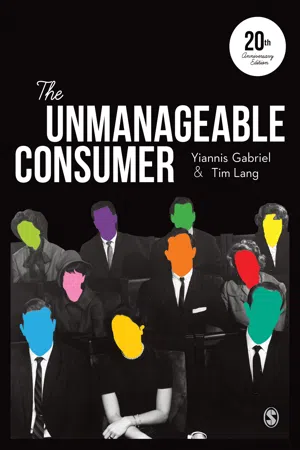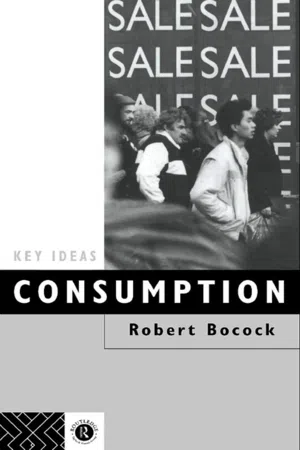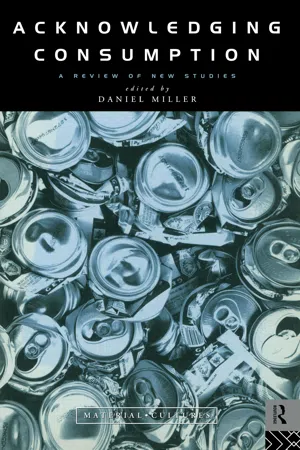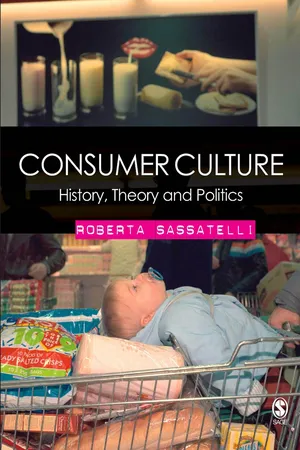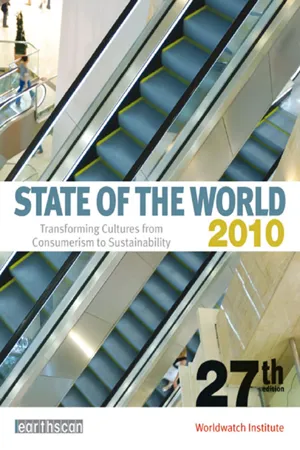History
Rise of Consumerism
The rise of consumerism refers to the increasing emphasis on the consumption of goods and services as a central aspect of modern society. This trend gained momentum in the 20th century, driven by factors such as mass production, advertising, and the expansion of credit. It has had a profound impact on economies, cultures, and individual lifestyles worldwide.
Written by Perlego with AI-assistance
Related key terms
Related key terms
1 of 4
Related key terms
1 of 3
9 Key excerpts on "Rise of Consumerism"
- eBook - ePub
Consumerism in World History
The Global Transformation of Desire
- Peter N. Stearns(Author)
- 2006(Publication Date)
- Routledge(Publisher)
The arrival of modern consumerism is no mystery. It resulted from a number of factors operating concurrently, from new products and new earnings to new needs, framed by changing culture including growing urban influence. Disputes continue about specifics, such as the role, if any, of emulating the aristocracy. And the mix of factors can be vigorously debated. Certainly there was no tidy, single cause for such a complex change. Many historians, furthermore, would disagree with the presentation in this chapter, as it ultimately gives special emphasis to initial consumerism as social compensation. Some place greater emphasis on the drawing power of the new commercial apparatus – shopkeeping and advertisement; and some look more to the cultural changes associated with early Romanticism. There is ample room for questioning and a real need for further analysis. Nevertheless, a number of key components are clear, and they help not only explain the emergence of consumerism but improve the definition of its meaning to the people involved.Several other issues remain. One involves both the range and intensity of early consumerism. The causes discussed above are so compelling that it may be tempting to assume that consumerism was more deeply rooted in the eighteenth century than in fact it was. As the previous chapter has already suggested, we do not know exactly how many people were caught up in consumer interests, or with what degree of commitment. The causes themselves help us differentiate certain groups. Urban people were more quickly and thoroughly involved than rural. Rural areas in contact with cities changed faster than rural areas in general. Young people moved toward consumerism faster than their older relatives, setting up a special relationship between advances in consumerism and youth culture that persists into the twenty-first century. People engaged in more secular cultural interests were more open than those attracted to religious fervor. The involvement with consumerism, clearly, was differentiated by setting and, doubtless, by individual personality as well.Furthermore, even for groups it touched, consumerism was not yet so profoundly anchored that it could not be displaced by other concerns. The early industrial revolution, developing between the 1780s and 1840s first in Britain, then in other parts of Western Europe, provided a striking example. Simply put, the new workers in the factories, who might have been popular consumers par excellence, turned out to value other goals more strongly for several decades.The process worked as follows. New factory workers were recruited from the ranks of former peasants, domestic manufacturers, and artisans. Many of them, in their backgrounds, would have been familiar with the kinds of consumerism that had developed in the eighteenth century. They were also disproportionately young, another favorable factor. Most important, they were involved in work that did not have clear status, but yielded a money wage. Factory work was often less skilled than artisanal labor, but it might pay better. Factory workers were often scorned by better-established urban residents. Here was a context in which consumerism might easily be used to demonstrate achievement and identity. - eBook - ePub
- Yiannis Gabriel, Tim Lang(Authors)
- 2015(Publication Date)
- SAGE Publications Ltd(Publisher)
The rest of this chapter sketches the emergence of Western consumerism and some of the contradictions that it faces today. We examine the circumstances that fostered it in the early phase of mass production and mass consumption in the 20th century. We trace its development through a period of mass media and advertising, examine its mutation in post-Fordist regimes and what some argued was a postmodern phase, and its resurgence in the era of the internet, and finally its possible dissolution into what some analysts already refer to as ‘post-consumerism’ (Lansley, 1994: 234–8; Gilbert, 2008; Cohen, 2013). The contradictions created within consumerism by environmental, population and political forces are cited by some commentators as the reasons for it moving in this direction.CORE ARGUMENTS
Consumerism emerged as a leading ideology in the 20th century and looks certain to play a major role in the 21st century. Identifying the good life with people’s ability to meet their desires through the accumulation of goods, consumerism elevates individual choice to a supreme value. It proclaims free markets as the guarantors of technological innovation, economic growth and political freedom. This ideology originated in the West but has now gone global. Consumerism was underpinned by a ‘Fordist Deal’, the deal behind the rise of mass production and mass consumption under which enhanced standards of living compensated for alienated work. This deal has unravelled with a global division of labour and new technological forces such as the internet which have seen jobs become more precarious and mobile. The major challenges for consumerism in the future look likely to arise from economic and political forces that depress wages and increase job insecurity; from increasing awareness of the adverse environmental impact of consumption; and from the failure of consumption to deliver the happiness and well-being that it promises. - eBook - ePub
- Dr Robert Bocock, Robert Bocock(Authors)
- 2008(Publication Date)
- Routledge(Publisher)
1 The emergence of modern consumerismThe social and cultural processes surrounding consumption in western capitalism during the twentieth century have been influ-enced by earlier cultural values, carried by various social status groups into the modern capitalist period. Among these carriers of cultural values, the early rational, peaceable, bourgeois capitalists of Britain and Holland, whose world-view was analysed by the German sociologist Max Weber (1864–1920) in The Protestant Ethic and the Spirit of Capitalism, have played a crucial role of world historical significance. Their migration, sometimes forced upon them, across the Atlantic, laid the basis of the modern United States of America—the social formation which has come to epitomise the modern consumer’s dreamland, or heaven on earth. The analysis Weber provided of this group, the early rational, Calvinist capitalists of the seventeenth century, will be discussed briefly here, before looking at later changes to this cultural patterning underpinning rational capitalism in the eighteenth century.The changes in patterns of consumption during late nineteenthand early twentiethcentury capitalism, up to the outbreak of the First World War in 1914, will be discussed in the light of the sociology of consumption from Veblen and of the newly emerging metropolitan life-style analysed by Simmel. The period of the two world wars, and the intervening economic recession and depression of the 1920s and 1930s, was one in which capitalism failed to deliver consumer goods to the working classes. Reflecting this bleak and violent economic and political period, sociologists concentrated on other issues, such as the appeal of fascism, rather than upon consumption.The story of the social and cultural role of consumption in modern, western capitalism continued with the growth of what was often called at the time, that is in the 1950s and 1960s, ‘the growth of mass consumption’. There were some interesting features of mass consumption which have been seen as distinctive of the period from the early 1950s up to the late 1960s. From the 1970s to the 1980s, some writers have argued that a new, even ‘post-modern’ pattern of consumption developed. The significance of this will be explored in the last part of this chapter. - eBook - ePub
- Daniel Miller(Author)
- 2005(Publication Date)
- Routledge(Publisher)
5 CONSUMPTION WITHIN HISTORICAL STUDIES
Paul Glennie
IThe significance of consumption for history
INTRODUCTION AND BACKGROUND
Earlier this century, industrial and agricultural revolutions were being discovered almost everywhere that historians looked. Recently it has been consumer revolutions, at least among European and American historians (little literature has hitherto addressed other histories of consumption, though see Clunas 1991). Phrases like the birth of consumer society, emergent modern consumption, the rise of mass consumption, and the rise of mass market culture have been applied to the sixteenth and early seventeenth centuries (Thirsk 1978); Restoration England (Earle 1989: Shammas 1990; Weatherill 1988); the early eighteenth century (Eversley 1967); the Georgian period (Campbell 1987; McKendrick, Brewer and Plumb 1982; Williams 1987); the late nineteenth century (Fox and Lears 1983; Fraser 1981; Lee 1981); and between the two World Wars (Miller 1991). And, of course, each account raises questions about defining ‘consumer society’, and about consumption’s connections to wider economic and cultural changes.This proliferation reflects both continuous growth in Western consumption, and historians’ various definitions of ‘consumer society’. In addition, work on consumption is characterised by fragmentation, with very many local case-studies. Most general treatments of consumption either cover short periods and a single country, or take a long-run comparative view only for certain goods. The sheer variety of available sources (artefactual, documentary, visual, literary), and the divergent agendas of specialised research fields in different countries, exacerbate diversity and fragmentation. Different histories inform, and are informed by, highly divergent general analyses on consumption, and many historians distrust explicit theorising as a comparative and synthesising device. - eBook - ePub
Consumer Culture
History, Theory and Politics
- Roberta Sassatelli(Author)
- 2007(Publication Date)
- SAGE Publications Ltd(Publisher)
To account for these, we do not need to build a stage theory of development (see Stearns 2001). Instead we can resort to an imagery of increasing but uneven stratification, whereby a variety of ongoing processes, among different sections of the population in different places and times, are piled one on another, partly displacing previous trends, partly resuming them. To outline the phenomenon of modern consumption, historiography has traditionally focused not only on the commercial cities of the Renaissance and the consumption of colonial produce of the 17th-18th centuries, but also, and especially, on a much more recent period which runs, approximately, from the second half of the 19th century to after the Second World War. Studies on the end of the 19th century overwhelmingly focus on the spread of department stores and the modern system of advertising; those on the post-war period are mostly concerned with the spread of mass-produced durable goods for domestic use, from fridges to televisions. To these we can add various sociological studies on contemporary society which underline the shift to a post-Fordist model of production and the subsequent diffusion, thanks also to new technologies, of ever more individualized flexible models of consumption. These different studies of the changes in the practices of consumption may be read via a focus on how consumption has been framed and which features have been ascribed to consumers as social actors. In the next few pages I shall briefly run through a selection of the crucial shifts which have characterized the consolidation of modern patterns of consumption in the last two centuries, suggesting an initial picture of the most important factors behind the historical formation of the consumer society (see Figure 2.2) - eBook - ePub
State of the World 2010
Transforming Cultures from Consumerism to Sustainability
- Worldwatch Institute(Author)
- 2013(Publication Date)
- Routledge(Publisher)
31But over time the emerging consumerist orientation was internalized by a growing share of the populace—with the continued help of merchants and traders—redefining what was understood as natural. The universe of “basic necessities” grew, so that by the French Revolution, Parisian workers were demanding candles, coffee, soap, and sugar as “goods of prime necessity” even though all but the candles had been luxury items less than 100 years earlier.32By the early 1900s, a consumerist orientation had become increasingly embedded in many of the dominant societal institutions of many cultures—from businesses and governments to the media and education. And in the latter half of the century, new innovations like television, sophisticated advertising techniques, transnational corporations, franchises, and the Internet helped institutions to spread consumerism across the planet.Arguably, the strongest driver of this cultural shift has been business interests. On a diverse set of fronts, businesses found ways to coax more consumption out of people. Credit was liberalized, for instance, with installment payments, and the credit card was promoted heavily in the United States, which led to an almost 11-fold increase in consumer credit between 1945 and 1960. Products were designed to have short lives or to go out of style quickly (strategies called, respectively, physical and psychological obsolescence). And workers were encouraged to take pay raises rather than more time off, increasing their disposable incomes.33Perhaps the biggest business tool for stoking consumption is marketing. Global advertising expenditures hit $643 billion in 2008, and in countries like China and India they are growing at 10 percent or more per year. In the United States, the average “consumer” sees or hears hundreds of advertisements every day and from an early age learns to associate products with positive imagery and messages. Clearly, if advertising were not effective, businesses would not spend 1 percent of the gross world product to sell their wares, as they do. And they are right: studies have demonstrated that advertising indeed encourages certain behaviors and that children, who have difficulty distinguishing between advertising and content, are particularly susceptible. As one U.S. National Academy of Sciences panel found, “food and beverage marketing influences the preferences and purchase requests of children, influences consumption at least in the short term, is a likely contributor to less healthful diets, and may contribute to negative diet-related health outcomes and risks among children and youth.”34 - eBook - ePub
- Russell W. Belk(Author)
- 2013(Publication Date)
- Routledge(Publisher)
CHAPTER ONE
THE RISE OF CONSUMER SOCIETY
The world is so full of a number of thingsI’m sure we should all be as happy as kings (Stevenson 1905)ON BEING AS HAPPY AS KINGS
Written during the rise of the age of consumerism, Stevenson’s couplet contemplates the abundant things of the world with a child’s sense of wonder. The happiness of kings is seen as a happiness that comes from having things. If this happiness was once restricted to kings it was because only they could command any thing they wished. But in a democratic consumer society within a market economy, the consumer is king. Given sufficient resources, any of us can now have our most regal material wishes fulfilled. The belief that such unbridled access to things should lead to unbridled happiness is the central premise of a consumer society.The development of contemporary consumer societies has had a profound effect on the way we view the world. Stated most simply, we have come to regard an increasing profusion of both natural and human-produced things as objects to be desired, acquired, savored, and possessed. Both individuals and social institutions have enthusiastically, if sometimes guiltily, embraced this world view. Perhaps the most prominent manifestation of such consumerism is in the proliferation of individual and institutional collections. For collecting is consumption writ large. It is a perpetual pursuit of inessential luxury goods. It is a continuing quest for self completion in the marketplace. And it is a sustained faith that happiness lies only an acquisition away. But while collecting may well be the stylized and distilled essence of a consumer orientation toward life, the conceptual relationship between collecting and consuming remains largely unexplored.This investigation of the interplay of collecting and consuming attempts to understand the interdependence of these phenomena both historically and in contemporary cultures. The primary focus is on collecting as a consumption activity that is shaped by the same cultural processes that affect other types of consumption activities. The dramatic growth of mass production, mass distribution, and mass communication is found to parallel the similarly dramatic growth of mass consumption, mass individual collecting, and massive museum collecting. More importantly, collecting is found to be a key activity that articulates our sometimes conflicting values concerning work and leisure, science and art, male and female, high culture and popular culture, us and the “other,” and production and consumption. These values are socially constructed and accordingly differ over times and cultures. My focus will be mainly on the phenomenon of collecting and on contemporary Western collecting. But before narrowing the focus too much, it is important to situate the development of consumption and collecting more broadly. - Di Zhu(Author)
- 2018(Publication Date)
- WSPC(Publisher)
After the reforms of 1978, with the transition to a market-based economy, Chinese people began to have access to various material goods and society also became more stratified. Throughout the 1980s, however, Chinese consumers were left ambivalent as they were confused about the “apparent inconsistency between a communist legacy emphasising austerity and equalitarianism and an emerging consumerist ethos celebrating individual hedonism and distinction-seeking through consumption” (Zhao and Belk, 2008: 3). Soon after the spring of 1992 when Deng’s “Southern talk” was released, the party began to actively encourage hedonism in order to transform people’s political zeal into sensational passions to be fulfilled through consumption (Ci, 1994, cited in Zhao and Belk, 2008). No matter what role the government plays in the rise of consumer culture, consumption patterns as well as consumer orientations have dramatically changed since the shift to a market-based economy. The ideology which advocates a rising consumer culture, with constant adjustments though, has remained in the official discourse ever since (Zhao and Belk, 2008).In contemporary society, the change of consumption patterns among Chinese people has been revealed by many studies in market and academic research. Through analysis of data from the National Statistic Bureau, it is found that household durables, rather than food, became the expenditure focus of the urban population during the period of 1985–1988, with an orientation to “spending the money due in the future” (chao qian xiao fei) (Hang, 2007: 57). From 1995 until 2006, the expenditure share of healthcare, telecom, education and housing (excluding purchasing of houses) increased more significantly among the urban population (ibid.: 59). At the micro level, as a result of rapid economic development (Li, 1996) and the growth of individual income (Lu, 1997), the purchasing power of Chinese people has been largely improved, which enabled them to pursue pleasure and comfort. Therefore, it is suggested that Chinese people became more enthusiastic for material goods and services that improve quality of life, and the desire of Chinese consumers has been far more than basic goods (McEwen et al- eBook - ePub
The History of Media and Communication
Consumer Activism and Corporate Public Relations in the 1930s
- Inger L. Stole(Author)
- 2010(Publication Date)
- University of Illinois Press(Publisher)
20Although some might have mourned a rapidly diminishing way of life, others welcomed the changes. Mass production of products that previously had required hours of work by skilled artisans enabled many people, including the poor and recent immigrants, to dress nicely and buy objects that only a few decades earlier had been reserved for the well-to-do. In her study of working-class immigrant women at the turn of the century, Kathy Peiss documents how participation in consumer culture provided a coveted ticket to social acceptance and freedom from patriarchal dominance. Andrew Heinze chronicles how turn-of-the-century Jewish immigrants used consumer products to buy social assimilation and acceptance. Other notable scholars have reached similar conclusions about the liberating aspects of consumer culture.21Despite its positive aspects, egalitarianism through consumption, or what the advertising historian Roland Marchand describes as democratization through goods, had its limitations. Although new and better merchandise could improve the material aspect of people’s lives, it was less suited to fulfill other functions. Consumer society, because it emphasized individual solutions to collective problems, helped articulate a new form of citizen sovereignty. Gradually winning acceptance was the view that it was in the marketplace, and not at the polls, where the public should cast its vote.22 Within this new society, argues the historian Charles McGovern, consumption was becoming a cornerstone, and this new version of democracy equated, even replaced, participation in civic life with spending dollars in the marketplace: “Consumption was the foundation of a distinctly American way of life; this was the new order of the ages.”23
Index pages curate the most relevant extracts from our library of academic textbooks. They’ve been created using an in-house natural language model (NLM), each adding context and meaning to key research topics.
Explore more topic indexes
Explore more topic indexes
1 of 6
Explore more topic indexes
1 of 4
